You are reading the older HTML site
Positive Feedback ISSUE
september/october 2008
The Acoustic Revive Chronicles, Chapter 4
by Jeff Day
Welcome to the Acoustic Revive Chronicles, Chapter 4. This is the first installment of the Acoustic Revive Chronicles here at Positive Feedback Online, but with this being Chapter 4, you're probably wondering where Chapters 1, 2, and 3 are. Well, the answer is that I came across the Acoustic Revive product line back when I was writing for Srajan over at 6Moons, so Chapters 1, 2, and 3 are stashed away in Srajan's archives. I thought I'd do a quick little recap of what happened in Chapters 1 - 3 for you so you wouldn't feel discombobulated by coming in on the middle of a developing story.
The Acoustic Revive system and room tuning accessories are from the creative mind of Mr. Ken Ishiguro, a life-long music and Hi-Fi aficionado who lives in Japan. Ken-San currently has five beautiful Hi-Fi systems at home, and also owns an audio shop, where he tests all of his Acoustic Revive designs to ensure they work well across a wide variety of equipment. Ken-San told me that his accessories are designed to help tune one's Hi-Fi system so that it will play a recording "so that it sounds natural and not as though it is being played back over an electrical device. Only by listening to natural sound without electronic artifice can you hear what the artists intended."
I first found out about the Acoustic Revive products from Mr. Yoshi Hontani, who is the exporter of the beautiful and musical Leben valve gear from Japan, which I use as my primary electronics reference (and am completely enamored with). Yoshi-San told me that he was very impressed with the Acoustic Revive system and room tuning accessories and asked me if I'd like to check out a couple of Acoustic Revive products, and I of course said "Sure!"
The couple of Acoustic Revive products I was expecting to receive for review actually turned out to be three big boxes of gear. Enough gear to give my entire system and room the complete Acoustic Revive treatment: The RD-3 Demagnetizer; RGC-24 Ground Conditioner; RIO-5 II Minus Ion Generator; Ultra Low-Frequency Pulse Generator R-77; Room Acoustic Conditioner RWL-2; Pure Smokey Quartz Insulator RIQ-5010 and Pure Quartz Insulator RIQ-5010W; Shorting Plugs SIP-8F; RPT-2 Ultimate and RPT-4 Ultimate Power Supply Boxes; CB-1DB Receptacle Base Plate; CFRP-1F Carbon Fiber Receptacle Plate; Ultimate Power Cable; and CS-2F Outlet Stabilizer!
I had so much Acoustic Revive gear in-house for review that I decided I'd better write about it in several installments as an act of self-preservation. Thus was born the Acoustic Revive Chronicles, a special series devoted to what I have found to be rather remarkable tuning products.
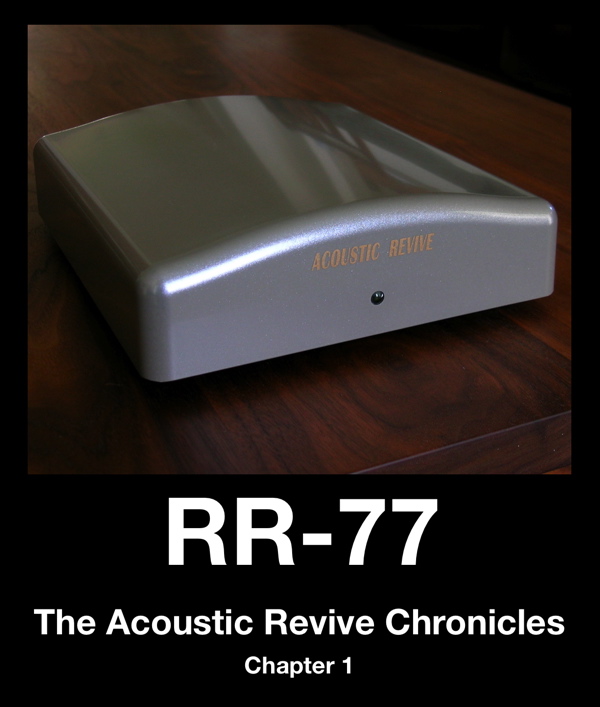
Chapter 1: The RR-77 Schumann Signal Generator
In the Acoustic Revive Chronicles, Chapter 1, article I introduced the RR-77 Schumann Signal Generator. The Acoustic Revive RR-77 is an active stand-alone device that doesn't plug into your Hi-Fi system. The idea behind the RR-77 is that it generates an ultra-low frequency 7.83Hz Schumann frequency pulse that 'shields' your HiFi electronics and listening room from radio frequency interference and thereby improves the S/N ratio so that the electronics perform better. The RR-77's ability to make everything more natural, smoother and more musically lifelike was a big hit with everyone that heard it in my listening room. My audio pals Stephaen and Pete both ordered RR-77s for their own use after hearing them in my rig.
With the RR-77 powered up, the sensation of space opened up in the recording acoustic, notes decayed in a much more natural fashion, and the edge, grit or glare I heard on lesser recordings became more tolerable and less offensive. The RR-77 pulls off a real magic act in accentuating the musicality of a recording and Hi-Fi rig. The sonic artifacts of the recording process (such as soundspace, soundstaging, imaging, detail recovery, and so forth) all had a dollop of naturalness applied to them so that they enhanced the musical content of recordings (like timbre, beat, meter, tempo, tonality, and harmony) so that the Hi-Fi musical experience was more like a live musical experience. The Schumann frequency is reported to have positive effects on human health and perception as well, and I did notice that when using it that I could listen all day long with zero listening fatigue. If anything, a listening session becomes energizing and edifying, and when a long nocturnal listening session was over I felt refreshed. I concluded that the RR-77 is a music lovers' winner if I'd ever heard one, and one that I "absolutely, unequivocally, and enthusiastically" recommended.
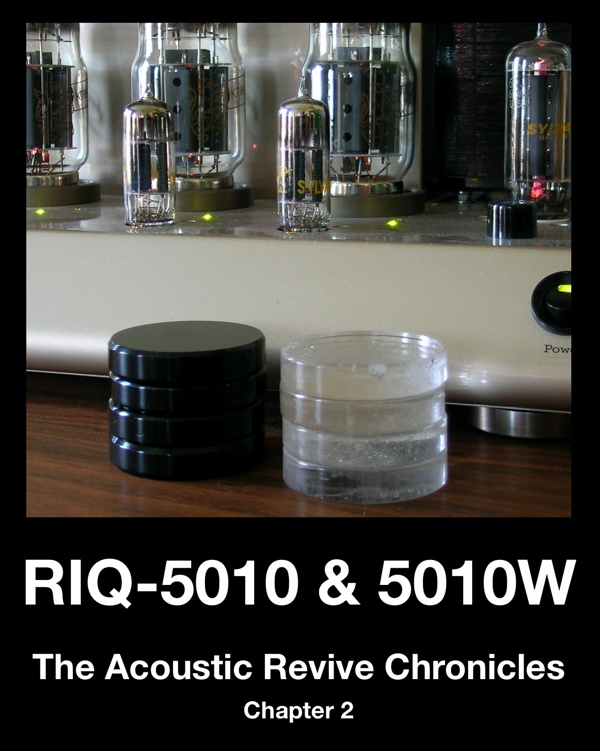
Chapter 2: The RIQ-5010, RIQ-5010W, and QR-8 Quartz Tuning Disks
In the Acoustic Revive Chronicles, Chapter 2, I introduced the RIQ-5010, RIQ-5010W, and the QR-8 quartz tuning disks. The Acoustic Revive RIQ-5010 (smoky) and RIQ-5010W (clear) are large natural quartz crystal disks 50mm by 10mm in size, or about the same size as typical equipment footers. They are mined as ore, then carved into disks and polished much as a jewelry gemstone would be. They are transparent with visible natural inclusions and very nicely made - jewel-like in fact. The basic idea behind their use as a system-tuning device is that vibrational energy which degrades your HiFi rig's performance is converted to another form or frequency of energy through quartz's piezoelectric properties, then dissipated to improve performance. The quartz disks can function either as isolators by separating two vibrating surfaces or as resonators when placed on one surface. In either case, the idea is to harness the piezoelectric properties of quartz for vibrational energy transformation to improve the sound of Hi-Fi electronics.
Ken-San told me, "Both the RIQ-5010 and RIQ-5010W will make the sound more realistic. There is a slight difference in sound between the two types. Smoky quartz will give you slightly more bass effects in articulation and extension. The clear quartz will give more transparency to high frequencies and will make the soundstage wider. Turning the quartz disk facing upwards or downwards has a bigger sound difference because quartz has a directional effect. It takes some effort but try and find the sweet spot direction of the insulator. If four insulators are facing the right direction, it will give a better phase characteristic to the sound. RIQ-5010 and RIQ-5010W are used underneath or on top of equipment."
I did as Ken-San suggested and began experimenting using the quartz disks with my Leben (and other) electronics. I found the effects across my electronics to be consistent: The clear quartz disks created a more open, detailed and transparent presentation from the midrange on up. I noticed little change below. The smoky quartz disks' effect from the midrange on down was to give a more spacious presentation, with the size of the soundspace increasing and better beat emphasis in the bass. From the midrange on up, the smoky quartz disks smoothed out sibilance and provided a more natural and less electronic overall feel.
The QR-8 quartz disks look like miniature versions of RIQ-5010 smoky quartz disks, each being about the size of an aspirin tablet. The QR-8 come eight to a package, have a thin adhesive film on one side, and are to be used as resonators by sticking them strategically on vibrating surfaces. The idea is that sticking a QR-8 on a vibrating surface will change the vibrational mode and eliminate the resonance. The QR-8 instruction sheet suggests all kinds of potential applications for the little quartz resonators: on the top, bottom, front or rear panels of equipment, positioned either in the center or in each of the four corners; positioned on the surfaces of loudspeaker cabinets; on the mounting plates of drivers; on listening room walls, ceilings or floors; on CD transports; on power switches; and inside electronics on vibration points like transformers, capacitors or even DAC chips. Only your imagination is the limit as to where to apply QR-8 resonators.
I treated my Harbeth Super HL5 loudspeakers with QR-8s: one in the bottom of the port, one on the super-tweeter mount, two on the tweeter mount and two on the midrange/woofer mount of each Harbeth Super HL5. With the addition of the QR-8s the sound took on a subtly more natural, less electronic overall character, with tone that was subtly more colorful and note decay trailed off longer. After I had written that review I also placed three of the QR-8s between each speaker and its Skylan stand (two in the front and one in the rear), which resulted in a rather larger change than with treating the drivers and ports of the Harbeths. The presentation became more articulate and natural sounding. All in all, the QR-8s were a nice improvement to the overall performance of the Harbeths, and remain in place to this day.
Essentially the effects of the RIQ-5010, RIQ-5010W and QR-8 quartz disks are similar after you find their sweet spot in your system or listening room: They make the music sound more natural, organic, life-like and less electronic, which has the net effect of getting you closer to the sound and feel of live music. I found there to be a cumulative effect, with the more of them I used in my system, the greater the magnitude of the change. By way of praise, let me simply say that the RIQ-5010, RIQ-5010W and QR-8 quartz disks remain in my system to this day, having passed the long-term test of musical satisfaction.
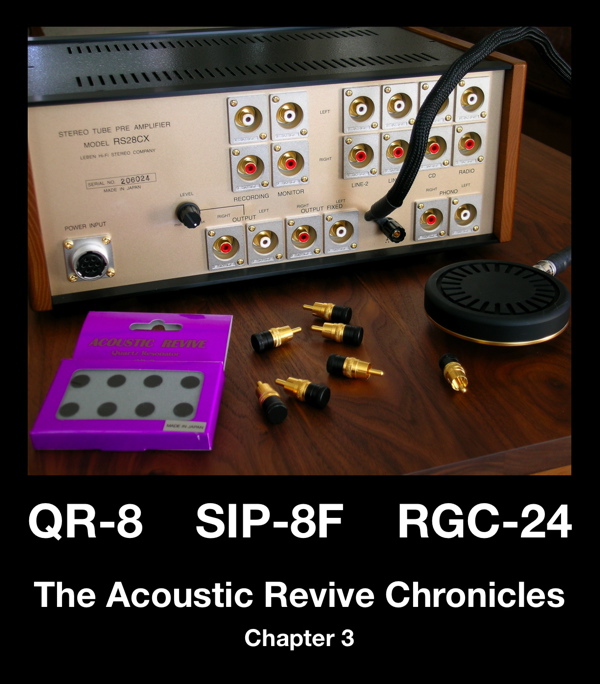
Chapter 3: The RGC-24 Ground Conditioner, the SIP-8F RCA Input Shorting Plugs, and the QR-8 Quartz Tuning Disks
In the Acoustic Revive Chronicles, Chapter 3, I introduced the RGC-24 Ground Conditioner, the SIP-8F RCA Input Shorting Plugs, and used the QR-8 Quartz Tuning Disks in a new way. The RGC-24 Ground Conditioner attaches to a preamplifier at its grounding connection as a "virtual ground". The RGC-24 consists of a beautifully crafted Duralumin chassis with a matte black Alumite finish, and a gold-plated brass plate for a base. Inside the chassis is a blend of tourmaline and other (i.e. proprietary blend) piezoelectric crystals that serve as the grounding medium. A solid core copper connecter (with natural silk buffer material, and a Teflon-coated flexible copper and carbon mesh tubing used as a covering) is provided to connect the grounding assembly to a preamp chassis mounting point. A rhodium-plated RBN-1 banana plug termination is used to connect to the RGC-24 chassis, and a gold plated Y-connector is used for connecting it to the preamp grounding point. If your preamplifier doesn't have a standard grounding connection, the RGC-24 includes a special RCA plug that can screw down on the Y-connector and be inserted into an empty RCA input to serve as a grounding connection. The RGC-24 positively exudes quality in its construction and materials.
The Acoustic Revive shorting plugs come in two models: the SIP-8F for RCA inputs and the BSIP-2F for XLR connectors. My Leben preamplifier uses only RCA connectors so I didn't try the XLR versions. Ken says, "The shorting plugs are not just a cover for vacant RCA inputs. By inserting these plugs, they will short-circuit the input circuit board and stop any RF noise from getting inside the equipment. By having the shorting plugs inserted, you will improve the S/N ratio and reduce the circuit boards' movement from vibration, which leads to dramatic improvement in sound quality." Ken-San also told me that the SIP-8F and BSIP-2F shorting plugs are made from a combination of 2017S Duralumin and brass designed to aid in vibration control, and when inserted into the RCAs they provide a sound quality improvement.
My reference Leben RS28CX full function vacuum tube preamplifier certainly doesn't need any help to sound fantastic. It pretty much blew me away straight out of the box with its excellent sonics and beguiling musicality. I figured the über-performing Leben preamplifier would be a good test of the RGC-24 Ground Conditioner, SIP-8F, and QR-8 quartz resonators. For if they could meaningfully improve on the Leben's formidable level of performance, well now, that would be something worth talking about.
I gave my Leben RS28CX preamplifier (and its RS28PX vacuum tube power supply in a separate chassis) the full Acoustic Revive treatment: I attached the Acoustic Revive RGC-24 Ground Conditioner to the grounding post on the back of the RS28CX chassis, treated the RS28CX and RS28PX interiors with QR-8 Quartz Resonators in strategic locations, and then fitted the unused RCA connections with the SIP-8F Shorting Plugs. Later I even tried adding QR-8 Quartz Resonators to the ends of the shorting plugs.
Did the RGC-24 Ground Conditioner, SIP-8F, and QR-8 quartz resonators make a difference? The answer is an emphatic yes. I was totally blown away by the huge increase in the recording acoustic and the huge billowing soundspace that just reached out and filled up my listening room to an unprecedented degree. More low-level detail was in evidence, and without any penalty of sounding more analytical. If anything, the overall character sounded more natural and less electronic; more like the real thing. Decay and bloom of notes increased but more importantly, the music just opened up and began to breathe akin to what you experience in a live performance. The tone color became even more ravishing, and the level of musical involvement was stepped up a couple of notches.
While the above description is a reference to all the Acoustic Revive gear in place on my Leben RS28CX preamplifier, I did listen to each of the products separately. However, there is a lot of additive effect by using the products together and I would recommend going for the whole treatment. It's definitely worth it. The RGC-24 grounding conditioner provided the biggest benefit. The RGC-24's contribution was a couple of multiples of the magnitude provided by the RR-77 Schumann resonance generator (i.e. a big-arsed effect). It provided more detail, more space, better imaging and more musical communication. The RGC-24 does help produce a more natural, less electronic, less sterile sound to create a more natural presentation that serves the music well. In my HiFi rig, the overall effect was dramatic enough that I nominated the RGC-24 grounding conditioner for a 6Moons Blue Moon Award back when—it's the real deal.
The Acoustic Revive SIP-8F RCA shorting plugs and the QR-8 quartz resonators both had a positive effect as well, but of a smaller magnitude than the RGC-24. If the RGC-24 scored an imaginary 10 for its increase, then I would award the shorting plugs an increase on the level of 4 and the quartz resonators a 3. Mathematically that would add up to an increase of 17 but because of synergy effects, the total is something more like 25. One interesting note: putting a quartz resonator on the end of each shorting plug made for a nice difference with the way notes decay and bloom. This resulted in a subtly more nuanced presentation and a more natural portrayal of the music. As with the Acoustic Revive gear reviewed in Chapters 1 and 2, the RGC-24 Ground Conditioner, the SIP-8F RCA Input Shorting Plugs, and the QR-8 Quartz Tuning Disks have passed the long-term test of user satisfaction and remain installed on my Leben preamplifier to this day.

Chapter 4: RPT-2 and RPT-4 Ultimate Power Distributors and the Power Reference Power Cables
Now that we've wrapped up our little recap of Chapters 1, 2, and 3 of the Acoustic Revive Chronicles let's move on to new ground. In Chapter 4 of I'll be covering the RPT-2 and RPT-4 Ultimate Power Distributors and the Power Reference power cables. The Ultimate Power Distributors come in two ($1295 USD), four ($2250 USD), and six ($2775 USD) outlet models. The Ultimate Power Distributors do not come with power cords, so you'll need to provide those. As you might expect I used the in-for-review Acoustic Revive Power Reference power cables ($750 USD for a 2 meter power cable) to connect to the Ultimate Power Distributors.
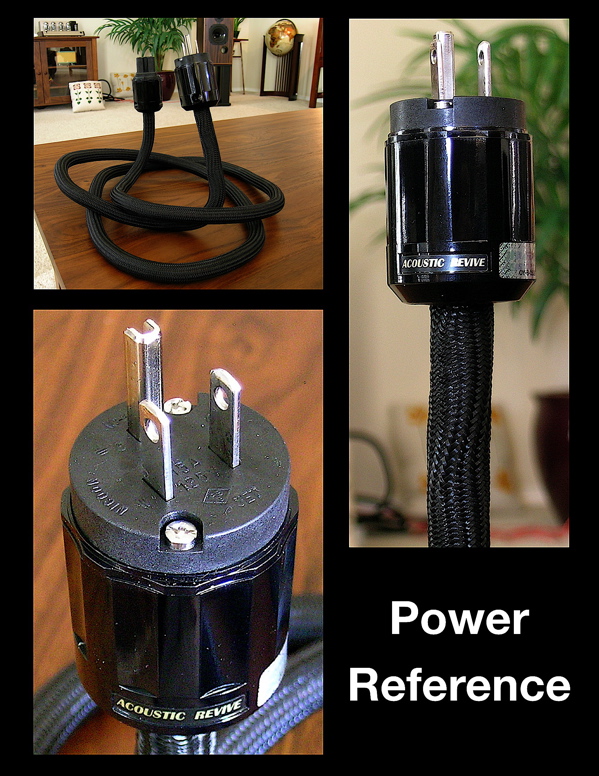
Power Reference Power Cables
The Acoustic Revive Power Reference power cables' materials are picked by ear to provide the best musical performance, and are hand crafted in a very laborious process that is described in detail on the Acoustic Revive web site here.
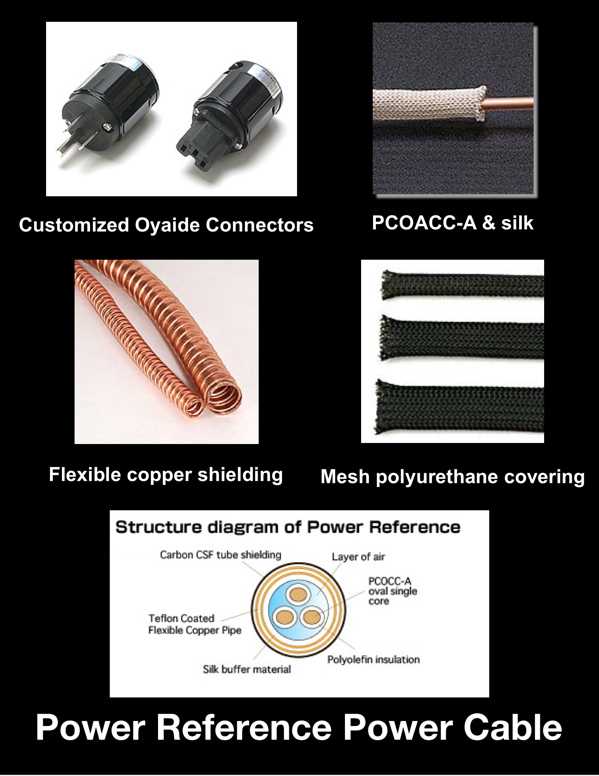
The Power Reference power cables utilize 2.6mm by 2.2mm oval Pure Copper by Ohno Continuous Casting (PCOCC-A) single core conductors. The 'A' on the PCOCC-A indicates that the conductors have been annealed. PCOCC-A is an ultra-high purity (greater than 8N) single-crystal copper conductor that has been annealed to increase its pliability and conductivity (see Figure 1). According to Acoustic Revive, single core conductors are superior to stranded cables because they do not have an "outbreak of straying electric current and distortion". Acoustic Revive makes a point of saying that the oval shape of their conductors means they do not have a resonance point, which contributes to a smoother, more transparent, three-dimensional, and articulate sound compared to other kinds of conductors.
The PCOCC-A conductors are covered with a natural silk dielectric, which Acoustic Revive says gives a more natural and spacious feel to the music. The silk covered PCOCC-A conductors are then covered with Teflon coated flexible copper tubing that provides 100% shielding from RFI. Acoustic Revive then covers the entire power cable assembly with mesh polyurethane tubing containing embedded carbon particles that provides additional shielding and vibration isolation. The plug ends of the Power Reference cables are customized Oyaide connectors whose conductive parts have been plated with silver and rhodium, then polished to a mirror-like finish before being cryogenically treated to further improve conductivity.

RPT-2 and RPT-4 Ultimate Power Distributors
I live in the Pacific Northwest of the USA where there is plenty of inexpensive and clean power. Every power conditioner I have tried in the past has degraded the sound of my Hi-Fi rig compared to power straight from my AC outlet. Acoustic Revive doesn't like the way normal power conditioners degrade the sound quality either, so they developed the Ultimate Power Distributors with the intent of not only not degrading the sound quality, but actually improving the sound quality by controlling vibration through materials design, and passively conditioning the electricity passing through them via the clever use of various compounds' quantum effects. As with the Power Reference power cables, I'll cover the high points of what goes into the Ultimates, but you can read a detailed account of what goes into them on the Acoustic Revive website here.
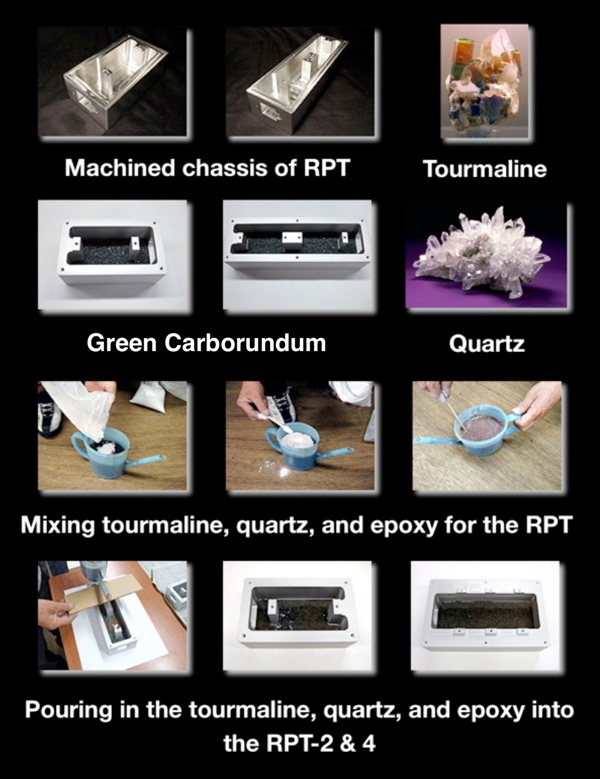
Acoustic Revive Ultimate Power Distributors start out life as a solid block of 2017 Duralumin, which is then machined into a chassis. The blocks of Duralumin that the RTP-2 Ultimate is machined out of weighs 3kg (6.6 pounds), 4kg (8.8 pounds) for the RPT-4 Ultimate, and 6kg (13.2 pounds) for the RTP-6 ultimate. Acoustic Revive says it takes them about 5 hours to carve out one chassis and top cover for an RTP-2 Ultimate, and about 8 hours for an RTP-4 Ultimate or RTP-6 Ultimate. Each Ultimate chassis is machined to have a maximum thickness of 25mm (approximately one inch) for vibration control and to screen out noise, thereby improving the signal-to-noise ratio. Acoustic Revive says their one-piece machined chassis works far better at controlling vibration than competing designs, with the result being better sound quality and less distortion. After the chassis and top plate are machined they are sandblasted, and then finished with an attractive and durable finish called Snow White Alumite (chassis) and Black Alumite (top plate), which appears to be similar to an anodized finish.
The finished chassis of the Ultimate Power Distributors are then filled with a combination of green carborundum powder (the purest form), tourmaline powder, and natural quartz powder. Green carborundum is a man-made compound of silicon and carbon that Acoustic Revive says absorbs "electromagnetic wave noise which is produced from receptacles and internal wiring. Green carborundum is the only electromagnetic wave absorbent material which improves sound quality and S/N ratio." After treating the chassis interior with green carborundum, a mixture of tourmaline powder, quartz powder, and epoxy is applied to the interior of the chassis and left to cure for a week. Acoustic Revive the piezoelectric mineral tourmaline reduces static electricity through the release of negative ions, and that the quartz powder "releases far infrared rays, which has a surface activation effect. This leads to very realistic sound filled with a feeling of throbbing pulse."
After the epoxy in the chassis has cured, height-adjustable chrome-plated machined brass footers are attached to the bottom of the RPT's chassis. The footers are fitted with a pad of high-tech vibration control material (developed by professor Masao Sumita at the Tokyo Institute of Technology) that eliminates vibration by converting vibrational energy to heat energy.
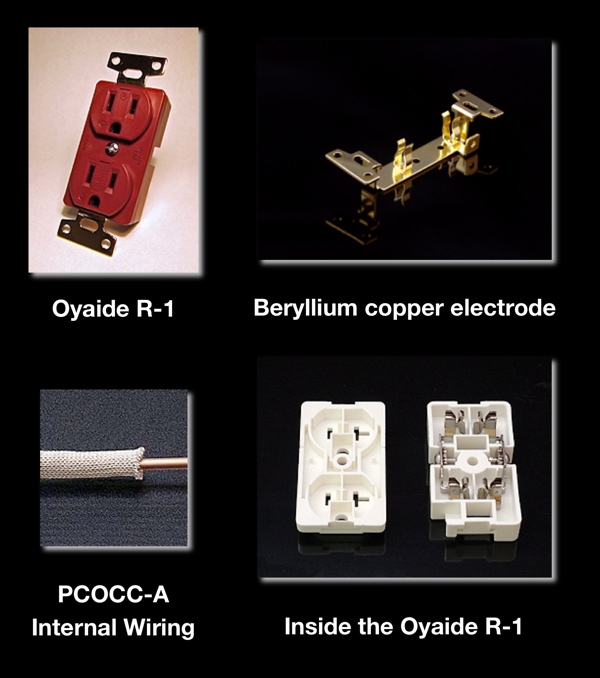
The receptacles in the RTP-2, 4 and 6 Ultimate are specially modified Oyaide R-1 receptacles. Oyaide R-1 receptacles are an ultra high-performance receptacle whose electrode material is made of highly conductive beryllium copper, which is designed to reduce vibration at contact points, with no loss of signal transmission. The R-1 is plated with a combination of platinum and palladium. Acoustic Revive modifies the Oyaide R-1 receptacles by applying thick silver and rhodium plating, and then cryogenically treating them at minus 196ºC to increase their conductivity. The housing of the R-1 is made of machined 30% glass filled polybutylene terephthalate (PTB).
Like the Oyaide R-1, Acoustic Revive has also applied thick silver and rhodium plating, and cryogenically treated, the conductive components of the power cord connectors. The interior wiring of the RPT is an annealed oval-shaped PCOCC-A (Pure Copper by Ohno Continuous Casting) single crystal copper with greater than 8Ns purity. Acoustic Revive chose to use the PCOCC-A wire because they thought that it provided much more natural sound quality than any of the round, rectangular, or flat shaped conductors they had tried.
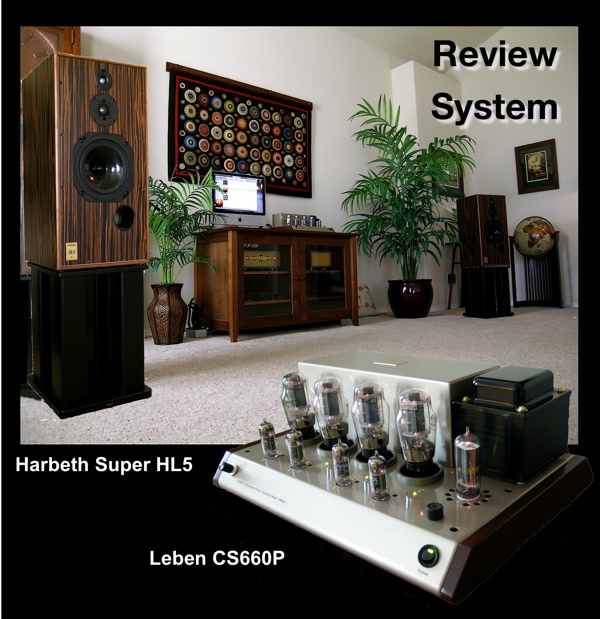
Listening Impressions
The system used for this review is listed in the accompanying sidebar in detail, but essentially consisted of an Apple iMac feeding digits to a Mhdt Labs Paradisea+ USB DAC, a Leben RS28CX doing preamplification duties, a Leben CS660P amp driving Harbeth Super HL5 loudspeakers, and Audio Tekne interconnects and speaker cables doing connection duties. In the listening sessions for this review I used mostly Valve Art 350B power tubes and NOS Sylvania 6CS7 inputs/drivers in the Leben CS660P, the stock NOS tube complement in the Leben RS28CX, and a NOS GE 5-Star 396A in the Paradisea+.
I used the Acoustic Revive Power Reference power cables on all of the components in my system (including the iMac), with digital components plugged into the RPT-2, and everything else plugged into the RPT-4. The RPT-2 and 4 were plugged directly into wall outlets using Power Reference power cables. As a comparator for the RPT-2 and 4 I used wall AC, which as I mentioned earlier, has always bested any kind of AC conditioner I've tried in the past where I live in the Pacific Northwest of the USA. As a comparator for the Acoustic Revive Power Reference power cable I used a Furutech G-320Ag-18 IEC power cable ($99 USD – the red cable plugged into the RPT-4 in the accompanying photo), a truly fine power cable in its own right.
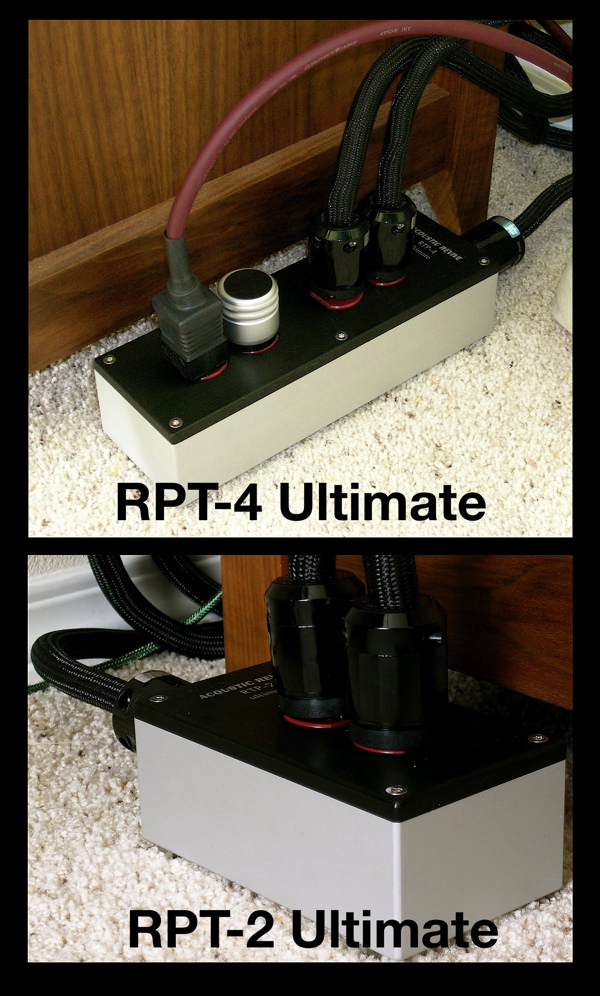
To start out the fun I did the simple test of taking the Acoustic Revive Power Reference power cord on my Leben CS660P amplifier that was plugged into my wall AC, and plugged it into the RPT-4 Ultimate Power Distributor. An explosion occurred when I hit 'play' on my Apple remote. Lest you misunderstand, my amp didn't blow up, but the music did. At least that's what it seemed like: Have you ever seen a nice backyard fireworks display? Think about that compared to a professional fireworks display done for a major event. With the fireworks pros the displays are more dramatic, bigger, more colorful, more exciting, more complex and entertaining, than anything you can do in your backyard. That's the kind of 'explosion' I'm talking about here.
Those sonic spatial and resolution aspects encoded into a album during the recording process, like soundstaging, imaging, transparency, perspective, a sense of space, and the like, became more dramatic, bigger, more exciting, more complex, and more entertaining with my Leben CS660P plugged into the RPT-4 Ultimate Power Distributor. It was not a subtle effect. In fact, it was one of those "Holy Cow!" moments that only come while reviewing on rare occasions. I was listening to the Joe Pass Virtuoso album at the time, and I was astonished at how much the image size increased, how the recorded perspective moved closer, and how much the sense of space increased.
But perhaps more important to long-term listening satisfaction was how the RPT-4 Ultimate improved the life-likeness of the musical content of recordings. Things like timbre, meter, tonality, harmony, beat, tempo, syncopation, and melody, all became more convincingly life-like. Overall, the presentation of the music became less artificial and electronic sounding, by taking on a warmer, rounder, and more deeply colorful tone. The music was also more naturally integrated in sound and time, and more compellingly musical in much the same way live music is more compelling than a recorded performance.
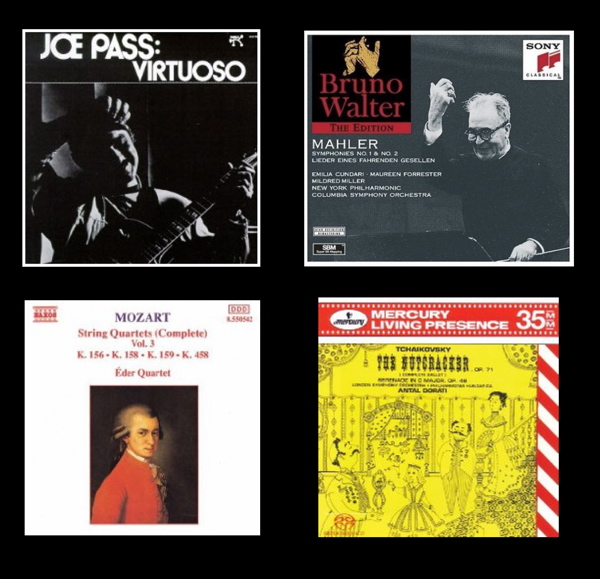
The more I listened with the RPT-4 Ultimate in the loop I realized that the individual timbral qualities of the five basic categories of musical instruments—strings, woodwinds, brass, percussion, and keyboard instruments—were more like you hear in life. They were more complex in overtones, and in the way notes trailed off and decayed, with more body and 'living' presence. Without the RPT-4 in the loop there is more of an electronic sheen on strings that competed with the tone of instruments, reducing their timbral believability, and thus, enjoyability. With the RPT-4 in the loop the sheen vanished and the tone of strings and became the centerpiece. Notes sounded more rounded, warmer, more expressive, and flowed more naturally in time in a more nuanced and complex way.
Normally the bass in the string choir of an orchestra plays a support role, but in the Mahler Symphony #1 in D Major (Bruno Walter, Columbia Symphony Orchestra), at the opening of movement 3, is a wonderful example of a string bass solo (playing a minor funereal version of Frere Jacques). This is a great reality check for string timbre and recorded perspective (how far away the bass sounds in the recording compared to what you would hear in a live performance). The bass should sound rich, dark, deep, and rosiny – and it does. The RPT-4 aids in this timbral reality by reducing electronic artifice that distracts the listener away from the music, which results in a more intensely colorful tone and richer timbral texture that is completely consonant detail-wise with the recorded perspective (not being either too detailed or too subdued for its distance away).
A string quartet serves as a nice way to check out timbral believability across the violin family of instruments (two violins, viola, and cello). When portrayed correctly by a stereo system, a string quartet should sound rich, homogenous, and non-fatiguing. If it doesn't you've got problems somewhere in your Hi-Fi rig. A good test of string timbre is Mozart's String Quartet in Bb Major, K. 458, in the opening of movement 1 (Eder Quartet, Naxos). For a full set of orchestral strings try Tchaikovsky's Serenade for Strings in C Major, op. 48, in movement 1 (Dorati, Mercury Living Presence). The RPT-4 (and 2) aids in realizing the full richness and homogeneity of the strings in a non-fatiguing fashion, just as it should.
The effect of the Acoustic Revive RPT-2/4 Ultimate Power Distributors on my listening was this: By reducing the electronic artifice of the AC noise on my Hi-Fi rig I went from listening to great recordings of great music, to forgetting about the recording, the gear, and just focusing in on the beauty and artistry of the music. The interesting part about all of this is that I don't think anyone would call my system electronic sounding in the way some Hi-Fi gear is, it's pretty natural sounding all the way around and does an excellent job of emphasizing the musical content of recordings. So I really didn't notice – at least until it was gone – how much of an electronic character there was still in my system due to noise artifacts in the AC supply.
There's other ways that the RPT-4 Ultimate affects the musical content of recordings too. The effects of temporal motion (i.e. tempo being the speed of the music) was more obvious, making it easier to sense how tempo's faster or slower 'feel' increases the emotional content of the music by adding a sense of excitement or relaxation, as the case may be. Music tends to sound more integrated in the way musicians harmonize with each other too. You get more of the sense of them playing together, sensing each other's hand on the music and responding in kind, rather than as disparate disconnected musicians recorded together.
In short, the RPT-4 reduces electronic artifice and lets the actual musical (and sonic) content of recordings come through more distinctly with truly meaningful results, results that I found to be quite addicting. Little things like getting a better sense of how the beat moves the music along, and being better able to follow the melodic line, all add up to provide a more musically satisfying performance.
Most importantly, with the RPT-4 (and the RPT-2 too of course) in my Hi-Fi rig, it better conveys those essential musical elements that make up the overall musical experience, presenting the music in a more believable and less electronic way across a wide variety of musical genres and varying recording quality. That's a major plus if you like to listen to a wide variety of music, and want to enjoy it all, like I do. And the Ultimates do this little magic trick while improving the sonics as well, something that doesn't always go hand in hand.
Now let's take a look at the Acoustic Revive Power Reference power cable, and see how it fares against the Furutech G-320Ag-18 IEC power cable that I have been using as my reference. In the string bass solo at the opening of movement 3 in Mahler's Symphony #1 in D Major (Bruno Walter, Columbia Symphony Orchestra), the Power Reference provides more of a sense of space, a better sense of tempo and melody, and a more textured and rosiny sense of bow on strings than does the Furutech. Having said that, I should note that it's not a huge difference, but it is noticeable and preferable.
The Power Reference provided a richer, more natural, string timbre, than did the Furutech in Mozart's String Quartet in Bb Major, K. 458, in the opening of movement 1 (Eder Quartet, Naxos). At times the Furutech sounded like the strings were distorting a little on peaks, where the Power Reference remained more natural and composed sounding. The Power Reference also provided clear timbral distinctions between the violins, viola, and cello, with a greater sense of textures of bow on string, than did the Furutech.
On the full set of orchestral strings of Tchaikovsky's Serenade for Strings in C Major, op. 48, in movement 1 (Dorati, Mercury Living Presence), it was much the same: the Power Reference was clearly better than the Furutech. The strings were a bit sharper and less detailed with the Furutech, and the decay of notes a bit truncated, compare to the Power Reference.
Another interesting tidbit: On The Stars and Stripes Forever (Gould, Brass and Percussion, Living Stereo) the piccolo doesn't come through nearly as clearly with the Furutech as compared to the Power Reference. It receded more into the background and was softened with the Furutech, something that a piccolo shouldn't do (after all, piccolo players wear earplugs for a reason when they play, as their instrument has the piercing ability to cut through any orchestra and make itself known). Bass is more dramatic with the Furutech, perhaps a bit more than it should be, so once again I give the nod to the Power Reference. Don't think that I'm dissing the Furutech, as I'm not, it's an amazingly good power cord for its price, but the Power Reference is in another league (which it should be for its price).
Summary and Conclusions
The Acoustic Revive RPT-2 and RPT-4 Ultimate Power Distributors, and the Acoustic Revive Power Reference power cables, deliver on their promised performance. They are beautifully made and are impressive in use. The RPT-2 and RPT-4 provided an enormous improvement in my system's performance. The Power Reference cables also provided a nice improvement, but to a lesser extent. Together though, they are spectacular. The ways in which the two products improve performance is similar: They both reduced the electronic character of the recorded music, making it more natural and like music you hear in life, and thus more satisfying and enjoyable.
It's interesting to note that these products provide a more natural and musical presentation while boosting performance in areas like soundstaging, imaging, transparency, perspective, and a sense of space. The overall effect is to make the music more dramatic, bigger, more exciting, more complex, and more entertaining. Normally you don't get improved naturalness and musicality with products that improve sonic performance, so that's quite an accomplishment.
As I noted earlier, I think the most important contribution the Acoustic Revive Ultimates and Power Reference cables make is to long-term listening satisfaction, by increasing the life-likeness of the musical content of recordings. Things like timbre, meter, tonality, harmony, beat, tempo, syncopation, and melody, all became more convincingly life-like. Overall, the presentation of the music becomes less artificial and electronic sounding. The music takes on more deeply colorful tone and more realistic timbral textures. The music also becomes more naturally integrated in sound and time, and more compellingly musical in the way live music is.
The Acoustic Revive products have made me a believer in the power of optimizing a system to realize its full musical potential. The truth is that my Hi-Fi rig has never sounded better than with the Ultimate Power Distributors and the Power Reference power cables in place. Highly, highly, recommended.
Pricing: The Ultimate Power Distributors come in two ($1295 USD), four ($2250 USD), and six ($2775 USD) outlet models. The Ultimate Power Distributors do not come with power cords, so you'll need to provide those. Acoustic Revive Power Reference power cables are $750 USD for a 2-meter power cable.
Quality of packing: Excellent.
Quality of construction: Extraordinary.
Condition of components received: Perfect.
Human interactions: Yoshi Hontani (Acoustic Revive exporter) is the best person to work with I can imagine. He is expedient, courteous and helpful. The same goes for Aki Monobe of Acoustic Revive and US importer Joe Cohen of the Lotus Group. A class act all the way around!
Acoustic Revive website: www.acoustic-revive.com/english/index.html
US importer's website: www.lotusgroupusa.com
Jeff Day's Associated Equipment
Digital: Apple iMac, Mhdt Labs Paradisea+ Vacuum Tube USB DAC (using various NOS GE, WE, Bendix, or Tung Sol vacuum tubes), Acoustic Revive Power Reference power cables on both, plugged into an Acoustic Revive RPT-2 Ultimate Power Supply Box.
Preamplifier: Leben RS28CX full function vacuum tube preamplifier (with MM phono stage), Leben RS28PX vacuum tube power supply in a separate chassis. Acoustic Revive RGC-24 Ground Conditioner attached to the grounding post on the back of the RS28CX chassis. RS28CX interior is treated with Acoustic Revive QR-8 Quartz Resonators in strategic locations. Unused RCA connections on the RS28CX are fitted with Acoustic Revive Shorting Plugs (SIP-8F) with QR-8 Quartz Resonators applied to their ends. An Acoustic Revive Power Reference power cable is used on the RS28PX, which in turn plugs into an Acoustic Revive RPT-4 Ultimate Power Distributor. The RS28PX power supply sits on a quartet of Acoustic Revive Pure Smokey Quartz Insulators (RIQ-5010), and the RS28CX preamp section on a quartet of Pure Quartz Insulators (RIQ-5010W).
Amplifier: A Leben CS-660P vacuum tube power amplifier, used with an Acoustic Revive Power Reference power cable, is plugged into an Acoustic Revive RGC-4 Ultimate Power Supply Box. Various types and brands of power tubes are used in the CS-660P: KT66, KT77, KT88, 6L6GC, 5881, EL34, and 350B. Either NOS Tung Sol or Sylvania valves are used as inputs/drivers.
Speakers: Harbeth Super HL5's, 18-inch Skylan stands, with 3 Acoustic Revive QR-8 Quartz Resonators between each speaker and its stand. The Harbeths are treated with QR-8 Quartz Resonators on the driver mounting plates and the speaker ports.
Cables: Audio Tekne ARC-500 interconnects.
Equipment Cabinet: McKinnon Furniture Bellevue Symphony walnut cabinet.
Room And System Tuning: Acoustic Revive REM-8 EMF Canceller, RCI-3 Cable Insulator, RD-3 Demagnetizer, RGC-24 Ground Conditioner, RIO-5 II Minus Ion Generator, Ultra Low-Frequency Pulse Generator R-77, Acoustic Conditioner RWL-3, Pure Smokey Quartz Insulator RIQ-5010 and Pure Quartz Insulator RIQ-5010W, Shorting Plugs SIP-8F, RPT-2 and RPT-4 Ultimate Power Distributors, CB-1DB Receptacle Base Plate, CFRP-1F Carbon Fiber Receptacle Plate, Power Reference power cable, CS-2F Outlet Stabilizer.
Listening Room: 20' L x 17' W x 17' H, sheet rock walls and cathedral ceiling, concrete slab floor (carpeted), open to a kitchen and dining room of similar size on rear wall, and open to an entry way on the right side wall.
